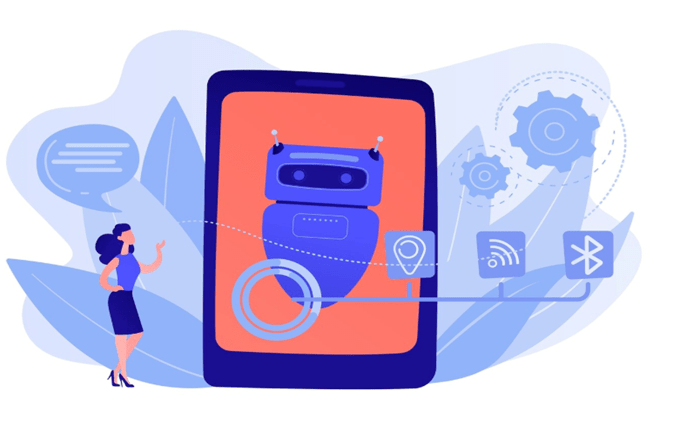
It’s 2 a.m., and your website just turned a casual browser into a booked call.
No sales rep, no wait time, no forms gathering dust in your CRM. Just a sharp, always-on AI chatbot—taking the lead, qualifying the inquiry, and teeing up your team for a close.
That’s not some Silicon Valley fantasy. That’s today. And it’s happening more often than you think.
According to recent reports, over 67% of consumers interacted with an AI chatbot in 2024—and most didn’t even realize it. What used to be clunky, clearly robotic scripts have become conversational pros that know when to pitch, when to listen, and when to connect someone to a real human.
If you’re still treating chatbots like a glorified FAQ page, you’re missing the point. AI chatbots have quietly become one of the most efficient ways to lead generation and take care of customers without burning out your team. Let’s break down how they’re doing it—and how you can, too.
What Makes AI Chatbots Actually Useful?
The phrase automated customer service might still carry some baggage. We’ve all yelled “talk to a human” at our phones. But today’s AI chatbots don’t live in the land of IVRs and keyword-based scripts. They learn. They adapt. And more importantly, they respond like actual people—just faster.
At their core, AI chatbots are trained to simulate human conversation in real time. But here’s where it gets interesting: they can handle thousands of queries at once, personalize interactions based on behavior, and sync with your systems to pull real data. Think appointment setting, order tracking, pricing questions, and yes—initial sales conversations.
And they never get tired.
Lead Generation That Works While You Sleep
Sales teams are busy. Leads fall through the cracks. Contact forms get filled out at odd hours and sit unanswered for too long.
AI chatbots fix that.
By using conversation flows built around your business goals, you can use AI chatbots to qualify leads in real time. Instead of waiting for a form submission to hit your inbox, your chatbot starts the conversation immediately—asking relevant questions, segmenting the user, and routing hot leads to the right rep.
Here’s how that plays out in practice:
- Someone clicks on your ad at 11:30 p.m.
- They land on your pricing page.
- Your chatbot greets them, asks what they’re looking for, and gathers context.
- If they meet your criteria, it books a call. If not, it nurtures them or offers self-service help.
No lost leads. No delays. Just clean handoffs—and real pipeline growth.
More Than Sales: The Customer Support Side of Chatbots
While AI chatbots are great at pulling leads into your funnel, they’re equally useful on the other side of the equation—keeping your customers happy after the sale.
Automated customer service has come a long way. The best AI chatbots today handle:
- Order status checks
- Troubleshooting common issues
- Password resets
- Appointment rescheduling
- Knowledge base queries
All without someone on your team having to lift a finger.
What does that mean for your business? Shorter wait times, faster resolutions, and a support team that can finally focus on the harder cases that actually need a human brain.
Think of it this way: your AI chatbot doesn’t replace your team. It clears the clutter, so your people can do what they do best.
Where AI Chatbots Really Shine: Consistency + Scale
Consistency is where most teams stumble. Your top sales rep can close like a pro, but can they take 50 leads at once? Can your support staff answer 100 inquiries simultaneously on their busiest day?
AI chatbots don’t blink at scale.
They offer a consistent experience to every user—every time. No mood swings. No burned-out responses. Just helpful, responsive interaction across your site, social platforms, and messaging apps.
That kind of consistency builds trust. And trust builds conversions.
So… How Do You Start?
If you’re curious about using AI chatbots but haven’t pulled the trigger yet, you’re not alone. The key is to start simple, with clear goals. Are you trying to qualify leads? Deflect support tickets? Book demos? Each use case has its own flow, tone, and handoff rules.
Here are some quick-start steps:
- Define the job. What specific tasks do you want your chatbot to handle—lead qualification, appointment setting, order lookups?
- Choose the right tool. There are plenty of options out there, from no-code builders like Tidio and ManyChat to enterprise-level platforms like Drift or Intercom.
- Build your flow. Start with your most common interactions. Write responses that sound human and helpful, not robotic.
- Connect the handoff. Make sure your bot knows when to loop in a real person—nothing’s worse than a bot that won’t let go.
- Track and tweak. Watch how users interact. Are they dropping off? Asking questions your bot can’t answer yet? Use that info to refine your setup.
Remember, it’s not about making the bot perfect on day one. It’s about creating a smart assistant that grows with your business.
What to Watch Out For
Even the best tech can go sideways if not handled well. Some common pitfalls to avoid:
- Over-automation. Don’t try to automate everything. If your chatbot can’t answer a question, let it escalate quickly.
- Sounding too robotic. Your bot should speak like your brand—not like a 90s helpdesk script.
- No analytics. If you’re not measuring conversation success, response time, or drop-off rates, you won’t know what’s working.
A well-built AI chatbot is part of your team. Treat it like one—train it, monitor it, and make sure it’s pulling its weight.
Final Word: You Don’t Need to Do More. You Just Need to Do It Smarter.
Using AI chatbots for lead generation and automated customer service isn’t about replacing people. It’s about giving your team room to focus on the work that matters most—and letting your chatbot take care of the rest.
Sales isn’t a 9-to-5 gig anymore. Neither is support. And in 2025, the brands that will stand out are the ones using tools that meet people where they are—right now, in real time, with answers that actually help.
Ready to put your chatbot to work?
Let it start the conversation. Your next client might already be asking.
Need help making your chatbot more than just a digital greeter?
At The it Crowd, we build real results into every campaign—and that includes smart, human-like bots that don’t just chat, but convert. Let’s talk.




